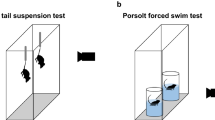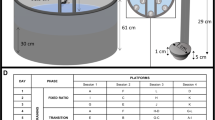Abstract
The forced swim test (FST) is one of the most commonly used animal models for assessing antidepressant-like behavior. This protocol details using the FST in rats, which takes place over 48 h and is followed by the video analysis of the behavior. The swim test involves the scoring of active (swimming and climbing) or passive (immobility) behavior when rodents are forced to swim in a cylinder from which there is no escape. There are two versions that are used, namely the traditional and modified FSTs, which differ in their experimental setup. For both versions, a pretest of 15 min (although a number of laboratories have used a 10-min pretest with success) is included, as this accentuates the different behaviors in the 5-min swim test following drug treatment. Reduction in passive behavior is interpreted as an antidepressant-like effect of the manipulation, provided it does not increase general locomotor activity, which could provide a false positive result in the FST.
This is a preview of subscription content, access via your institution
Access options
Subscribe to this journal
Receive 12 print issues and online access
$259.00 per year
only $21.58 per issue
Buy this article
- Purchase on Springer Link
- Instant access to full article PDF
Prices may be subject to local taxes which are calculated during checkout
Similar content being viewed by others
References
Kessler, R.C. et al. The epidemiology of major depressive disorder: results from the National Comorbidity Survey Replication (NCS-R). J. Am. Med. Assoc. 289, 3095–3105 (2003).
Murray, C.J. & Lopez, A.D. Alternative projections of mortality and disability by cause 1990–2020: Global Burden of Disease Study. Lancet 349, 1498–1504 (1997).
Licinio, J. & Wong, M.L. Depression, antidepressants and suicidality: a critical appraisal. Nat. Rev. Drug Discov. 4, 165–171 (2005).
Matthews, K., Christmas, D., Swan, J. & Sorrell, E. Animal models of depression: navigating through the clinical fog. Neurosci. Biobehav. Rev. 29, 503–513 (2005).
Porsolt, R.D., Le Pichon, M. & Jalfre, M. Depression: a new animal model sensitive to antidepressant treatments. Nature 266, 730–732 (1977).
Porsolt, R.D., Bertin, A. & Jalfre, M. 'Behavioural despair' in rats and mice: strain differences and the effects of imipramine. Eur. J. Pharmacol. 51, 291–294 (1978).
Porsolt, R.D., Anton, G., Blavet, N. & Jalfre, M. Behavioural despair in rats: a new model sensitive to antidepressant treatments. Eur. J. Pharmacol. 47, 379–391 (1978).
Cryan, J.F. & Holmes, A. The ascent of mouse: advances in modelling human depression and anxiety. Nat. Rev. Drug Discov. 4, 775–790 (2005).
Petit-Demouliere, B., Chenu, F. & Bourin, M. Forced swimming test in mice: a review of antidepressant activity. Psychopharmacology (Berl.) 177, 245–255 (2005).
Porsolt, R.D., Bertin, A. & Jalfre, M. Behavioral despair in mice: a primary screening test for antidepressants. Arch. Int. Pharmacodyn. Ther. 229, 327–336 (1977).
Rupniak, N.M. et al. Comparison of the phenotype of NK1R−/− mice with pharmacological blockade of the substance P (NK1) receptor in assays for antidepressant and anxiolytic drugs. Behav. Pharmacol. 12, 497–508 (2001).
Einat, H., Kronfeld-Schor, N. & Eilam, D. Sand rats see the light: short photoperiod induces a depression-like response in a diurnal rodent. Behav. Brain. Res. 173, 153–157 (2006).
Lucki, I. The forced swimming test as a model for core and component behavioral effects of antidepressant drugs. Behav. Pharmacol. 8, 523–532 (1997).
Cryan, J.F., Markou, A. & Lucki, I. Assessing antidepressant activity in rodents: recent developments and future needs. Trends Pharmacol. Sci. 23, 238–245 (2002).
Cryan, J.F. & Mombereau, C. In search of a depressed mouse: utility of models for studying depression-related behavior in genetically modified mice. Mol. Psychiatry 9, 326–357 (2004).
Slattery, D.A., Desrayaud, S. & Cryan, J.F. GABAB receptor antagonist-mediated antidepressant-like behavior is serotonin-dependent. J. Pharmacol. Exp. Ther. 312, 290–296 (2005).
Cryan, J.F., Valentino, R.J. & Lucki, I. Assessing substrates underlying the behavioral effects of antidepressants using the modified rat forced swimming test. Neurosci. Biobehav. Rev. 29, 547–569 (2005).
Borsini, F. & Meli, A. Is the forced swimming test a suitable model for revealing antidepressant activity? Psychopharmacology (Berl.) 94, 147–160 (1988).
Slattery, D.A., Neumann, I.D. & Cryan, J.F. Transient inactivation of the infralimbic cortex induces antidepressant-like effects in the rat. J. Psychopharmacol. (Oxford, England) 25, 1295–1303 (2011).
Slattery, D.A. & Cryan, J.F. Animal models of depression – where are we going? in Depression from Psychopathology to Pharmacotherapy (eds. J.F. Cryan & B.E. Leonard) (S. Karger, Basel, 2011).
Katz, M.M., Bowden, C.L. & Frazer, A. Rethinking depression and the actions of antidepressants: uncovering the links between the neural and behavioral elements. J. Affect. Disord. 120, 16–23.
Cryan, J.F., Page, M.E. & Lucki, I. Differential behavioral effects of the antidepressants reboxetine, fluoxetine, and moclobemide in a modified forced swim test following chronic treatment. Psychopharmacology (Berl.) 182, 335–344 (2005).
Detke, M.J., Johnson, J. & Lucki, I. Acute and chronic antidepressant drug treatment in the rat forced swimming test model of depression. Exp. Clin. Psychopharmacol. 5, 107–112 (1997).
Cryan, J.F. & Slattery, D.A. Animal models of mood disorders: recent developments. Curr. Opin. Psychiatry 20, 1–7 (2007).
Gould, T.D. & Gottesman, I.I. Psychiatric endophenotypes and the development of valid animal models. Genes Brain Behav. 5, 113–119 (2006).
Hasler, G., Drevets, W.C., Gould, T.D., Gottesman, I.I. & Manji, H.K. Toward constructing an endophenotype strategy for bipolar disorders. Biol. Psychiatry 60, 93–105 (2006).
Ravindran, A.V., Matheson, K., Griffiths, J., Merali, Z. & Anisman, H. Stress, coping, uplifts, and quality of life in subtypes of depression: a conceptual frame and emerging data. J. Affect. Disord. 71, 121–130 (2002).
Morley-Fletcher, S. et al. Chronic treatment with imipramine reverses immobility behaviour, hippocampal corticosteroid receptors and cortical 5-HT(1A) receptor mRNA in prenatally stressed rats. Neuropharmacology 47, 841–847 (2004).
Rygula, R. et al. Anhedonia and motivational deficits in rats: impact of chronic social stress. Behav. Brain Res. 162, 127–134 (2005).
Rygula, R. et al. Citalopram counteracts depressive-like symptoms evoked by chronic social stress in rats. Behav. Pharmacol. 17, 19–29 (2006).
Hill, M.N., Brotto, L.A., Lee, T.T. & Gorzalka, B.B. Corticosterone attenuates the antidepressant-like effects elicited by melatonin in the forced swim test in both male and female rats. Prog. Neuropsychopharmacol. Biol. Psychiatry 27, 905–911 (2003).
Brotto, L.A., Gorzalka, B.B. & Barr, A.M. Paradoxical effects of chronic corticosterone on forced swim behaviours in aged male and female rats. Eur. J. Pharmacol. 424, 203–209 (2001).
Cryan, J.F., Hoyer, D. & Markou, A. Withdrawal from chronic amphetamine induces depressive-like behavioral effects in rodents. Biol. Psychiatry 54, 49–58 (2003).
Detke, M.J. & Lucki, I. Detection of serotonergic and noradrenergic antidepressants in the rat forced swimming test: the effects of water depth. Behav. Brain Res. 73, 43–46 (1996).
Jacobson, L.H. & Cryan, J.F. Feeling strained? Influence of genetic background on depression-related behavior in mice: a review. Behav. Genet. 37, 171–213 (2007).
Lucki, I., Dalvi, A. & Mayorga, A.J. Sensitivity to the effects of pharmacologically selective antidepressants in different strains of mice. Psychopharmacology (Berl.) 155, 315–322 (2001).
Lopez-Rubalcava, C. & Lucki, I. Strain differences in the behavioral effects of antidepressant drugs in the rat forced swimming test. Neuropsychopharmacology 22, 191–199 (2000).
Overstreet, D.H., Rezvani, A.H. & Parsian, A. Behavioural features of alcohol-preferring rats: focus on inbred strains. Alcohol Alcohol. 34, 378–385 (1999).
Friedman, E., Berman, M. & Overstreet, D. Swim test immobility in a genetic rat model of depression is modified by maternal environment: a cross-foster study. Dev. Psychobiol. 48, 169–177 (2006).
Scott, P.A., Cierpial, M.A., Kilts, C.D. & Weiss, J.M. Susceptibility and resistance of rats to stress-induced decreases in swim-test activity: a selective breeding study. Brain Res. 725, 217–230 (1996).
West, C.H. & Weiss, J.M. A selective test for antidepressant treatments using rats bred for stress-induced reduction of motor activity in the swim test. Psychopharmacology (Berl.) 182, 9–23 (2005).
Cryan, J.F., Page, M.E. & Lucki, I. Noradrenergic lesions differentially alter the antidepressant-like effects of reboxetine in a modified forced swim test. Eur. J. Pharmacol. 436, 197–205 (2002).
Author information
Authors and Affiliations
Contributions
D.A.S. and J.F.C. contributed equally to the manuscript.
Corresponding author
Ethics declarations
Competing interests
The authors declare no competing financial interests.
Supplementary information
Supplementary Video 1
Example of immobility behavior (MOV 979 kb)
Supplementary Video 2
Example of swimming behavior (MOV 2839 kb)
Supplementary Video 3
Example of climbing behavior (MOV 3263 kb)
Supplementary Data 1
Example of results and analysis of a dataset (XLSX 15 kb)
Rights and permissions
About this article
Cite this article
Slattery, D., Cryan, J. Using the rat forced swim test to assess antidepressant-like activity in rodents. Nat Protoc 7, 1009–1014 (2012). https://doi.org/10.1038/nprot.2012.044
Published:
Issue Date:
DOI: https://doi.org/10.1038/nprot.2012.044
This article is cited by
-
Characterization of graded 6-Hydroxydopamine unilateral lesion in medial forebrain bundle of mice
Scientific Reports (2024)
-
GM-1020: a novel, orally bioavailable NMDA receptor antagonist with rapid and robust antidepressant-like effects at well-tolerated doses in rodents
Neuropsychopharmacology (2024)
-
Hypothalamic Gene Expression in a Rat Model of Chronic Unpredictable Mild Stress Treated with Electroacupuncture
Neurochemical Research (2024)
-
Comparing the antidepressant-like effects of electroconvulsive seizures in adolescent and adult female rats: an intensity dose–response study
Biology of Sex Differences (2023)
-
Anti-apoptotic effect of menaquinone-7 protects the brain of ovariectomized rats
Beni-Suef University Journal of Basic and Applied Sciences (2023)
Comments
By submitting a comment you agree to abide by our Terms and Community Guidelines. If you find something abusive or that does not comply with our terms or guidelines please flag it as inappropriate.



